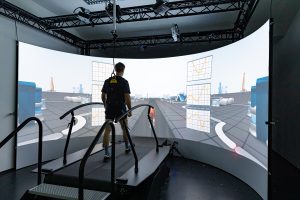A smartphone that runs on a treadmill

Using a smartphone while walking takes a toll on the whole body – a study conducted at the GRAIL Mobility Laboratory on the FH campus in Vienna suggests. (© FH Campus Vienna/Schedl)
There is no doubt that smartphones are affecting our daily lives. Even our movement is affected. However, in this context, smartphone zombies aren't about clogging the sidewalks staring at the device. A study by a research team from Vienna's FH campus found that our technological companions also have an impact on our musculoskeletal system: smartphones knock on the knees.
The smartphone aisle is wide and the steps are short. A fall back emergency plan due to the multiple stresses of using a smartphone and walking at the same time. It is associated with misalignment of the knees, losing the swinging arms to maintain body balance and seeking additional stability. A text walker becomes an X-Walker.
This is a somewhat abridged version of the media response to a study from early January. Sebastian Durstberger, Klaus Witthalm and Peter Putz from the FH campus in Vienna investigated the question of how smartphones affect our musculoskeletal system in the Gait Realtime Analysis Interactive Lab (GRAIL). However, they did not have in mind the subtle, but potentially traumatic, attention deficit effects of road users staring at their smartphones – which would be somewhat unethical in terms of study design – but rather how smartphone use while walking affects gait and gait. This causes long-term effects on the body.
“The aim of the research was to compare a normal, unadulterated gait that can be achieved while using a smartphone at the same time. We wanted to find out if the gait changes and if there is adverse stress on the knee joint,” explained project leader Sebastian Durstberger. Center for Identity Skills and faculty in graduate programs Physical therapy And Health Assisted Engineering Publication of FH Campus Vienna, University of Applied Sciences. “Studies show that the body switches to some sort of defense mechanism when using a smartphone. As gait speed decreases, there is a simultaneous increase in gait width.
Although these small, wide steps reduce the risk of falls, they also lead to more stress on the outside of the knee joint, which promotes a minimal X position in the knee joint. This can lead to permanent damage in the long term: cartilage and meniscus can lose their elasticity over the years, leading to arthritis in the worst case, researchers predicted after treadmill experiments.
In other words, technophile optimists' proud progress toward the future turns into a waddle. However, before you continue to play off the completely harmful effects of technology from OFF, you should first take a closer look at the study.
So I had a quick look at the related featured article. Fortunately, the editors of the broadcast linked directly to the featured article in the journal Science. An initial scan of the text yielded a solid impression of a study that was found conclusive by several scientists in peer review. However, at the same time, a quick perusal of the technical paper, “Effects of Smartphone Use During Walking at Peak External Knee Abduction Moment: A Crossover Randomized Trial on an Instrumented Treadmill,” revealed the authors of the technical paper to have several limitations evident. They told themselves.
- First, there is the small size of the sample: a total of 27 people participated in the study. It is not enough to make a public statement.
- A second limitation is related to the task: for the study, test subjects had to perform very complex calculations while walking on a treadmill in the GRAIL movement laboratory, which took up most of their attention.
- Ultimately, however, the experiment's setup represents a limitation: a treadmill like the one in GRAIL, even if it simulates a natural environment in great detail, is ultimately still a treadmill. People may move slightly differently on a treadmill than on solid ground.
This is clear. The authors of the study made no general statements. But it would be wrong to dismiss the study. Rather, the research team has provided an important data point in describing a larger problem. In other words, it's a head start to work ahead. To do this, you can now search data from health insurance companies to see if knee problems are over-reported (boring); Many doctors ask if their patients report new/different knee problems (long); or compare the developments of different population groups in comprehensive long-term studies. However, to do this, control groups would have to be denied smartphones, which would be unethical.
I am sure that other research groups will develop new, exciting approaches based on the study, thus contributing to further knowledge about people and their relationship with technology. The results of the study are now being processed by the FH Campus Vienna in a broadcast that serves as the basis for reports with a slightly humorous tone, and incidentally draws attention to the institute's research activities. – at its best.